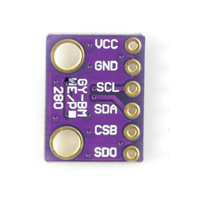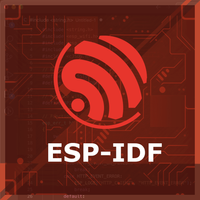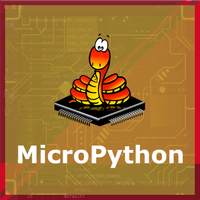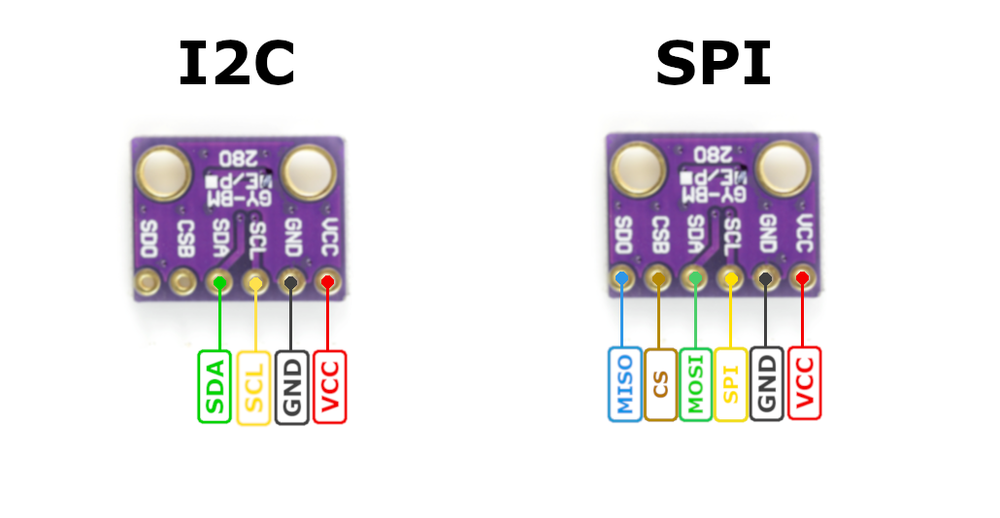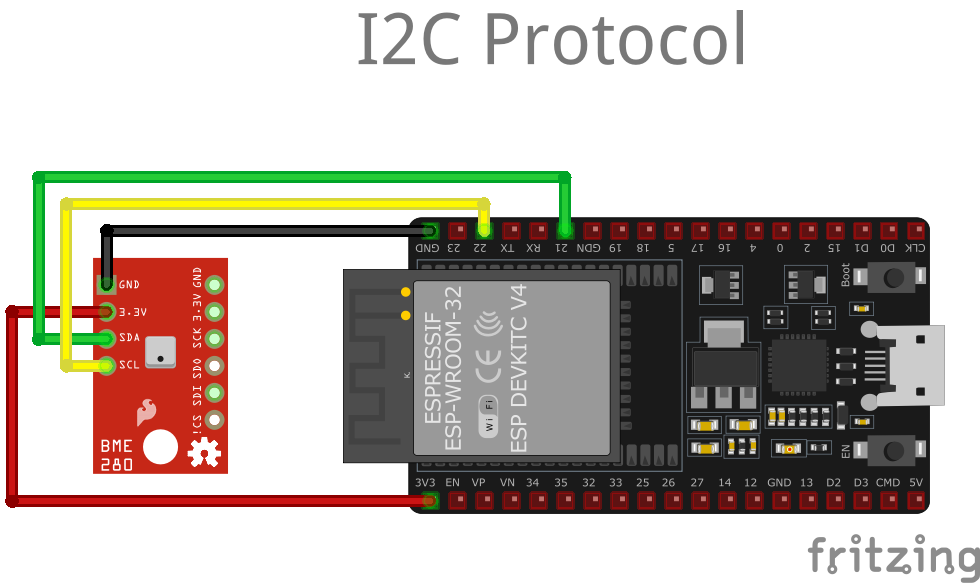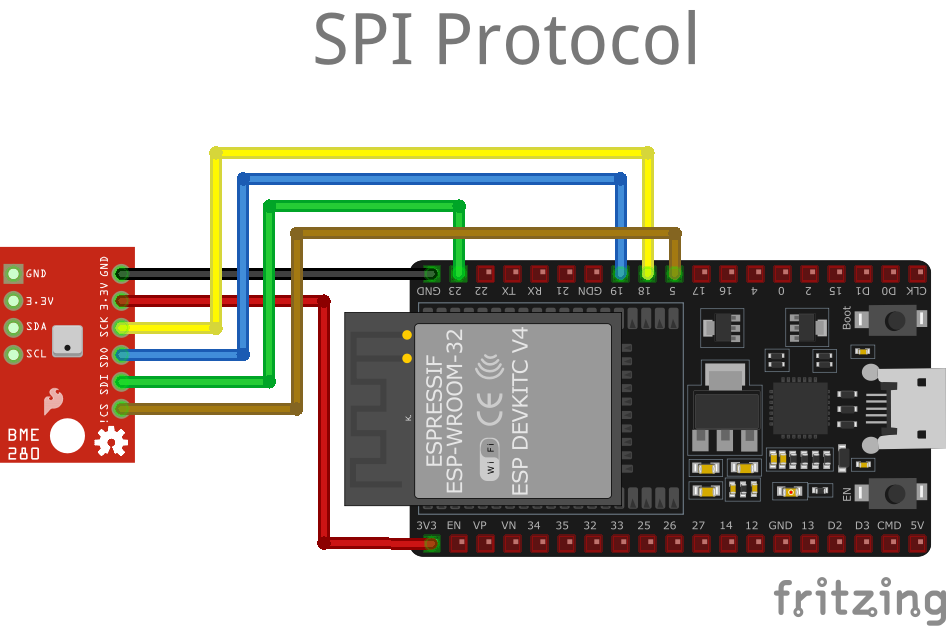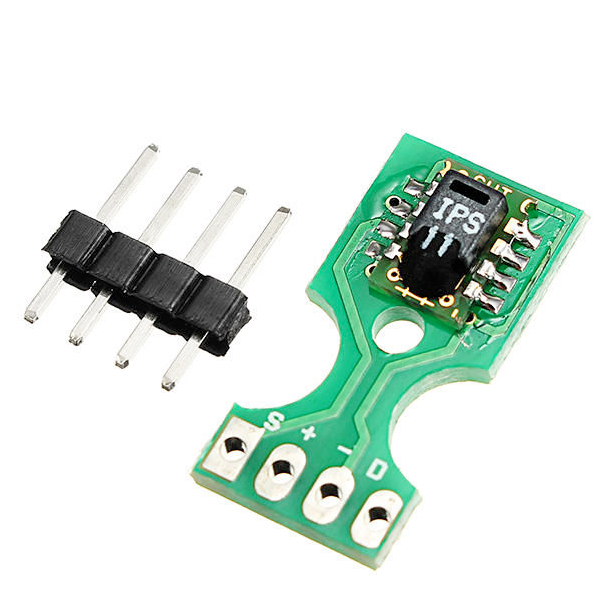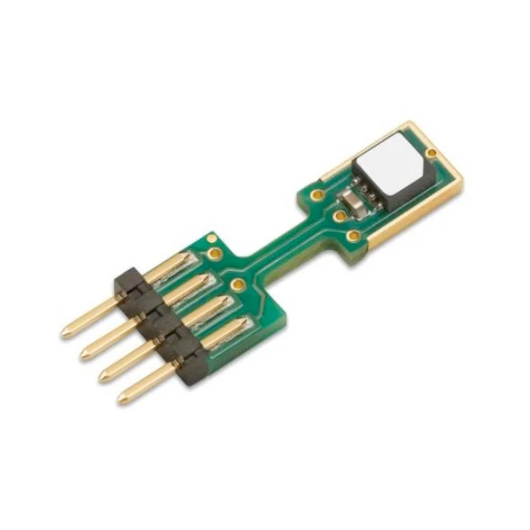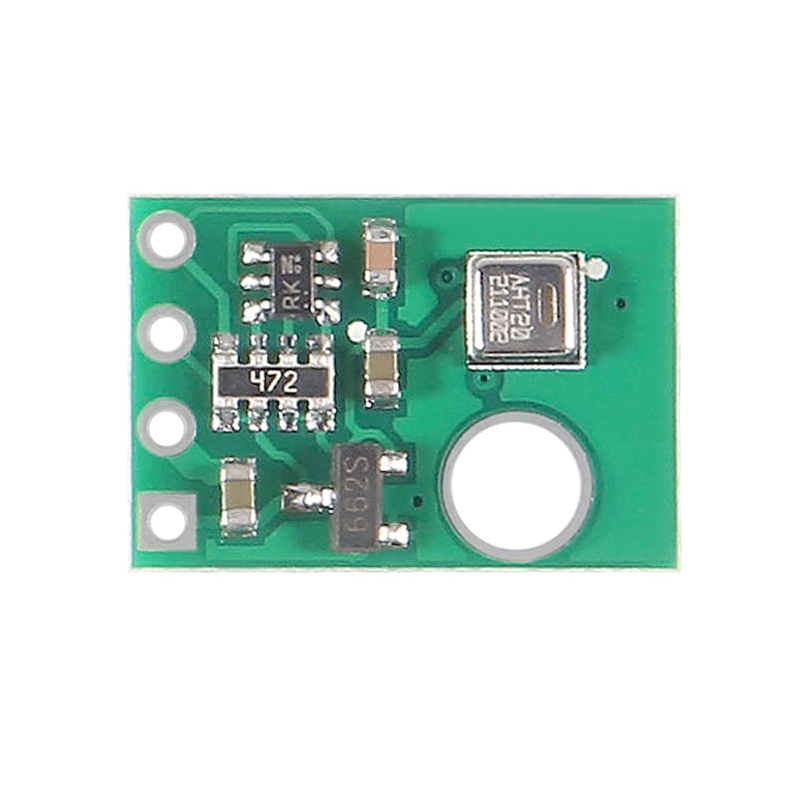ESP32 BME280 Temperature and Humidity Sensor
Overview
The BME280 is a compact digital sensor by Bosch Sensortec, designed for measuring temperature, humidity, and pressure with high accuracy and low power consumption. It supports both I²C and SPI communication protocols, making it versatile for integration into IoT devices, weather stations, and portable electronics. Operating within a wide range of environmental conditions, it features a small 2.5mm x 2.5mm package.
About BME280 Temperature and Humidity Sensor
The BME280, developed by Bosch Sensortec, is a highly integrated environmental sensor that provides accurate temperature, humidity, and pressure measurements. Its low power consumption and compact size make it perfect for IoT, wearables, and weather monitoring applications.
⚡ Key Features
- 3-in-1 Sensing – Measures temperature (-40°C to 85°C), humidity (0–100% RH), and pressure (300–1100 hPa).
- Multiple Communication Interfaces – Supports I²C and SPI for flexible integration.
- Ultra-Low Power – Consumes as little as 1.8 µA, ideal for battery-powered devices.
- Compact Design – Small 2.5 × 2.5 × 0.93 mm form factor for space-constrained applications.
🔗 Learn more about the BME280 sensor.
Where to Buy



Prices are subject to change. We earn from qualifying purchases as an Amazon Associate.
Technical Specifications
Pinout Configuration
The VCC pin is used to supply power to the sensor, and it typically requires 3.3V or 5V (refer to the datasheet for specific voltage requirements). The GND pin is the ground connection and must be connected to the ground of your ESP32.
SCL (clock) and SDA (data) pins. These pins connect to the respective clock and data lines of the microcontroller. The I2C protocol is efficient for minimal wiring, requiring only two data pins. For the SPI protocol, the sensor uses four pins: SCK (clock), SDI (MOSI), SDO (MISO), and CS (chip select). This setup provides higher data transfer speeds and is suitable for applications requiring fast and reliable communication. Both protocols also use VIN (or VCC) for power (typically 3.3V or 5V) and GND for grounding.Wiring with ESP32
- SCK (SCL Pin): GPIO 22
- SDI (SDA Pin): GPIO 21
- SCK (SPI Clock): GPIO 18
- SDO (MISO): GPIO 19
- SDI (MOSI): GPIO 23
- CS (Chip Select): GPIO 5
Troubleshooting Guide
Common Issues
🔍 I2C Sensor Found, but Could not find a valid BME280 sensor
Issue: The I2C scanner detects the BME280 sensor, but example sketches fail to initialize it.
I2C device found at addres 0x76Could not find a valid BME280 sensor, check wiring, address, sensor ID!
Some cheeap BME280 named sensors does not actually work with the Adafruit library, due to the I2C Bus Timing - different libraries configure I2C clock speeds differently, which might cause issues with sensors that cannot keep up with faster communication.
Solution: Try using different library instead of Adafruit_BME280.h, such as the BME280.h
🆔 Incorrect Sensor Identification
Issue: The sensor is identified incorrectly, leading to initialization failures..
SensorID was: 0x0ID of 0xFF probably means a bad address, a BMP 180 or BMP 085ID of 0x56-0x58 represents a BMP 280,ID of 0x60 represents a BME 280.ID of 0x61 represents a BME 680.
Some modules labeled as BME280 are actually BMP280, which lacks the humidity sensor.
Solution: If the sensor is a BMP280, use the BMP280 library (Adafruit_BMP280.h) instead of the BME280 library.
Debugging Tips
🔍 Serial Monitor
Use the Serial Monitor to check for error messages and verify the sensor's output. Add debug prints in your code to track the sensor's state.
⚡ Voltage Checks
Use a multimeter to verify voltage levels and check for continuity in your connections. Ensure the power supply is stable and within the sensor's requirements.
Additional Resources
Code Examples
Arduino Example
#include <Wire.h>
#include <Adafruit_Sensor.h>
#include <Adafruit_BME280.h>
/* Uncomment these lines if using SPI interface
#include <SPI.h>
#define SPI_CLK 18
#define SPI_MISO 19
#define SPI_MOSI 23
#define SPI_CS 5
*/
#define SEA_LEVEL_PRESSURE (1013.25) // Standard sea level pressure
Adafruit_BME280 environmentSensor; // Using I2C for communication
//Adafruit_BME280 environmentSensor(SPI_CS); // Use for hardware SPI
//Adafruit_BME280 environmentSensor(SPI_CS, SPI_MOSI, SPI_MISO, SPI_CLK); // Use for software SPI
unsigned long refreshInterval;
void setup() {
Serial.begin(9600);
Serial.println(F("Initializing BME280 Sensor"));
bool initSuccess;
// Initialize sensor with default settings (I2C address 0x76)
initSuccess = environmentSensor.begin(0x76);
if (!initSuccess) {
Serial.println("Sensor initialization failed. Verify wiring and connections.");
while (1); // Halt execution if sensor is not found
}
Serial.println("-- Running Default Configuration --");
refreshInterval = 1000; // Data refresh every 1000 ms
Serial.println();
}
void loop() {
displaySensorData();
delay(refreshInterval);
}
void displaySensorData() {
Serial.print("Temperature: ");
Serial.print(environmentSensor.readTemperature());
Serial.println(" °C");
// Optional: Uncomment for Fahrenheit conversion
/Serial.print("Temperature: ");
Serial.print(1.8 * environmentSensor.readTemperature() + 32);
Serial.println(" °F");/
Serial.print("Pressure: ");
Serial.print(environmentSensor.readPressure() / 100.0F);
Serial.println(" hPa");
Serial.print("Estimated Altitude: ");
Serial.print(environmentSensor.readAltitude(SEA_LEVEL_PRESSURE));
Serial.println(" meters");
Serial.print("Humidity: ");
Serial.print(environmentSensor.readHumidity());
Serial.println(" %");
Serial.println();
}This code is configured for I2C communication by default, with the BME280 sensor initialized using its default I2C address (0x76). However, it includes commented-out sections for using SPI communication as an alternative protocol.
Library Installation #
To use this code, you need to install the Adafruit BME280 library. Follow these steps:
- Open Arduino IDE.
- Navigate to Sketch → Include Library → Manage Libraries.
- Search for "Adafruit BME280" and install it.
Alternatively, you can download the library from the official Adafruit GitHub repository:
🔗 Adafruit BME280 Library
ESP-IDF Example
#include <stdio.h>
#include "esp_log.h"
#include "bme280.h" // BME280 driver for ESP-IDF (you need to include this library)
#define I2C_MASTER_SCL_IO 22 // GPIO number for I2C SCL
#define I2C_MASTER_SDA_IO 21 // GPIO number for I2C SDA
#define I2C_MASTER_NUM I2C_NUM_0 // I2C port number
#define I2C_MASTER_FREQ_HZ 100000 // I2C frequency
#define BME280_I2C_ADDR 0x76 // BME280 I2C address
void app_main(void)
{
static i2c_bus_handle_t i2c_bus = NULL;
static bme280_handle_t bme280 = NULL;
//Step1: Init I2C bus
i2c_config_t conf1 = {
.mode = I2C_MODE_MASTER,
.sda_io_num = I2C_MASTER_SDA_IO,
.sda_pullup_en = GPIO_PULLUP_ENABLE,
.scl_io_num = I2C_MASTER_SCL_IO,
.scl_pullup_en = GPIO_PULLUP_ENABLE,
.master.clk_speed = I2C_MASTER_FREQ_HZ,
};
i2c_bus = i2c_bus_create(I2C_MASTER_NUM, &conf1);
//Step2: Init bme280
bme280 = bme280_create(i2c_bus, BME280_I2C_ADDRESS_DEFAULT);
bme280_default_init(bme280);
//Step3: Read temperature, humidity and pressure
float temperature = 0.0, humidity = 0.0, pressure = 0.0;
bme280_read_temperature(bme280, &temperature);
bme280_read_humidity(bme280, &humidity);
bme280_read_pressure(bme280, &pressure);
}Key Features #
- I2C communication is configured with SDA on GPIO 21 and SCL on GPIO 22 at 100 kHz.
- The BME280 sensor is initialized at I2C address
0x76. - The sensor readings include temperature, humidity, and pressure.
Library Requirement #
This code uses the BME280 driver for ESP-IDF, which must be installed. To install the required library, run the following command in the ESP-IDF environment:
idf.py add-dependency "espressif/bme280^0.1.1"Alternatively, you can download the library from the official ESP-IDF component registry:
🔗 ESP-IDF BME280 Library
Code Breakdown #
I2C Initialization
- The I2C bus is configured using
i2c_config_tand initialized withi2c_bus_create(). - The SDA and SCL lines have pull-up resistors enabled.
- The I2C bus is configured using
BME280 Sensor Setup
- The sensor is initialized with
bme280_create(), using the I2C bus handle. - The function
bme280_default_init()configures the sensor with default settings.
- The sensor is initialized with
Reading Sensor Data
- The code retrieves temperature, humidity, and pressure data using:
bme280_read_temperature()bme280_read_humidity()bme280_read_pressure()
- These values can be printed to the console or used in further processing.
- The code retrieves temperature, humidity, and pressure data using:
Customization #
- This implementation can be expanded to log data, send values to a cloud server, or trigger events based on environmental conditions.
- Additional configurations can be made to adjust sampling rates, filtering, or power modes.
This setup ensures reliable communication with the BME280 sensor using ESP-IDF’s I2C API.
ESPHome Example
sensor:
- platform: bme280_i2c
temperature:
name: "BME280 Temperature"
pressure:
name: "BME280 Pressure"
humidity:
name: "BME280 Humidity"
# Example configuration entry SPI
sensor:
- platform: bme280_spi
temperature:
name: "BME280 Temperature"
pressure:
name: "BME280 Pressure"
humidity:
name: "BME280 Humidity"
cs_pin: GPIOXXThe following YAML configuration sets up two sensor platforms for a BME280 sensor:
bme280_i2c:Configures the BME280 sensor using the I2C interface.The temperature, pressure, and humidity readings are named accordingly.bme280_spi:Configures the BME280 sensor using the SPI interface.It includes an additional parametercs_pinto specify the chip select pin.
PlatformIO Example
platformio.ini
[env:esp32dev]
platform = espressif32
board = esp32dev
framework = arduino
monitor_speed = 115200
lib_deps =
adafruit/Adafruit BME280 Library @ ^2.2.2
adafruit/Adafruit Unified Sensor @ ^1.1.7
build_flags =
-DBME280_I2C ; Define if using I2C
; -DBME280_SPI ; Uncomment if using SPIPlatformIO Example Code
#include <Wire.h>
#include <Adafruit_Sensor.h>
#include <Adafruit_BME280.h>
// Define I2C address or SPI pins
#define SEALEVELPRESSURE_HPA (1013.25)
Adafruit_BME280 bme;
void setup() {
Serial.begin(115200);
if (!bme.begin(0x76)) { // Replace 0x76 with your I2C address
Serial.println("Could not find a valid BME280 sensor, check wiring!");
while (1);
}
}
void loop() {
Serial.print("Temperature = ");
Serial.print(bme.readTemperature());
Serial.println(" °C");
Serial.print("Pressure = ");
Serial.print(bme.readPressure() / 100.0F);
Serial.println(" hPa");
Serial.print("Humidity = ");
Serial.print(bme.readHumidity());
Serial.println(" %");
Serial.println();
delay(2000);
}This program configures a BME280 sensor using PlatformIO. Key steps include:
- Library Inclusions: Include
Wire.h,Adafruit_Sensor.h, andAdafruit_BME280.hfor I2C communication and sensor interfacing. - PlatformIO Setup: Add required libraries in
platformio.iniunderlib_deps:lib_deps = adafruit/Adafruit BME280 Library @ ^2.2.2 adafruit/Adafruit Unified Sensor @ ^1.1.7 - Sensor Initialization: Use
bme.begin(0x76)for I2C (replace with0x77if needed). - Data Reading: Read temperature, pressure, and humidity with
bme.readTemperature(),bme.readPressure(), andbme.readHumidity().
MicroPython Example
import time
from machine import I2C, Pin
from bme280 import BME280
# Initialize I2C
i2c = I2C(1, scl=Pin(22), sda=Pin(21)) # Adjust pins as needed (e.g., SCL=22, SDA=21)
# Initialize BME280
bme = BME280(i2c=i2c)
while True:
# Read data from the BME280
temperature = bme.temperature
pressure = bme.pressure
humidity = bme.humidity
# Print data to the console
print("Temperature:", temperature)
print("Pressure:", pressure)
print("Humidity:", humidity)
print("-" * 30)
time.sleep(2) # Wait 2 seconds before the next readingThis MicroPython code reads data from a BME280 sensor using I2C. Key steps:
from machine import I2C, Pin: Initializes I2C communication with the specified pins (e.g., SCL=22, SDA=21).
from bme280 import BME280: Imports the BME280 library, which must be in the same directory.
bme = BME280(i2c=i2c): Creates a BME280 object to interact with the sensor.
The main loop reads temperature, pressure, and humidity using bme.temperature, bme.pressure, and bme.humidity, printing the results every 2 seconds.
Conclusion
The ESP32 BME280 Temperature and Humidity Sensor is a powerful environment sensor that offers excellent performance and reliability. With support for multiple development platforms including Arduino, ESP-IDF, ESPHome, PlatformIO, and MicroPython, it's a versatile choice for your IoT projects.
For optimal performance, ensure proper wiring and follow the recommended configuration for your chosen development platform.
Always verify power supply requirements and pin connections before powering up your project to avoid potential damage.
